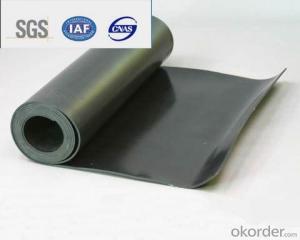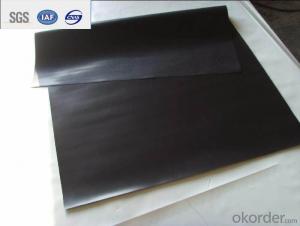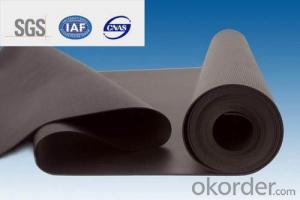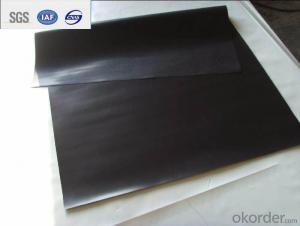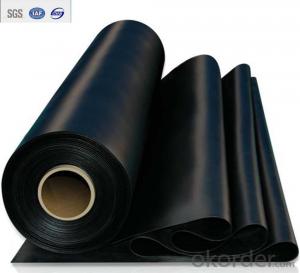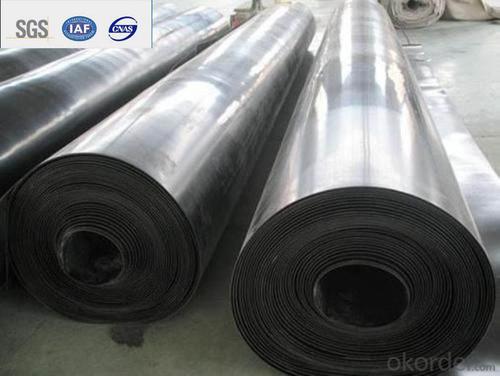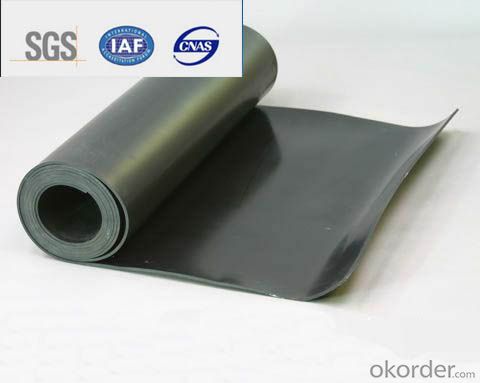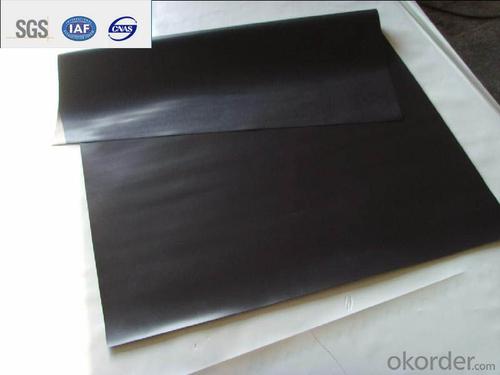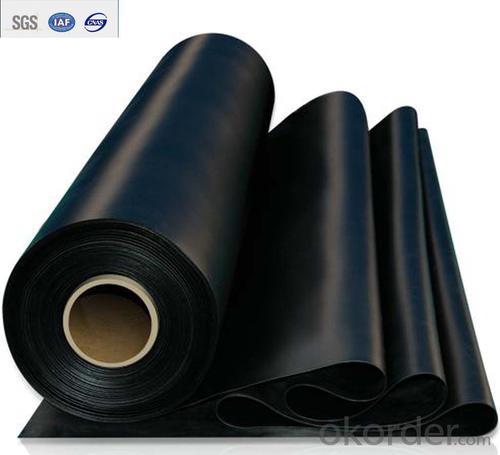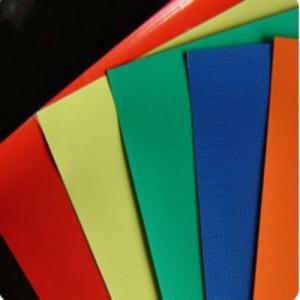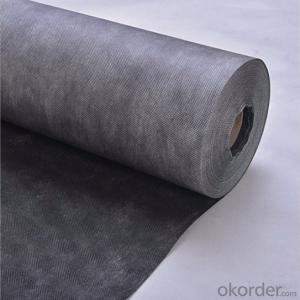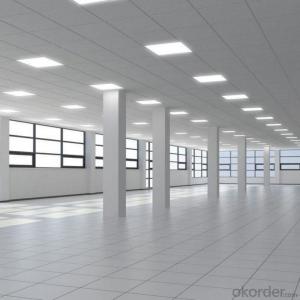EPDM Waterproofing Roofing Membrane with 1.2mm 2.0mm
- Loading Port:
- Qingdao
- Payment Terms:
- TT OR LC
- Min Order Qty:
- 2000 m²
- Supply Capability:
- 800000 m²/month
OKorder Service Pledge
OKorder Financial Service
You Might Also Like
Description Of EPDM Rubber Waterproof Membrane:
1. EPDM waterproof membrane is made from ternary ethylene-propylene rubber, which is for waterproofing of exposed and non-exposed applications.
2. EPDM waterproof membrane production adopts the world-advanced equipment of cold feeding extrusion and continuous vulcanization technology.
3. EPDM waterproof membrane is of high elasticity among high polymer waterproof materials and becomes a world-popular waterproofing material.
Main Features of EPDM Rubber Waterproof Membrane:
1. Excellent physical and mechanical performance
2. High tearing resistance
3. Good deformation adaptability
4. High puncture resistance
5. High aging resistance
6. UV resistance
Specifications of EPDM Rubber Waterproof Membrane:
Material | EPDM Rubber |
Size | 1.2m (width)*20m (length) or customized, weldable type 2.05m or 4m width |
Thick | 1.2mm, 1.5mm, 2.0mm |
Type | Vulcanized & Weldable |
Pattern | Non-reinforced (homogeneous) |
Certificate | ISO9001/14001 |
Applications of EPDM Rubber Waterproof Membrane:
1.Roofs, Basement, Toilets
2. Industrial and civil building waterproofing
3. Geosynthetic liner for swimming pool, channels, irrigation system
4. Especially suitable for projects with high requirements in durability, anti-corrosion and deformation.
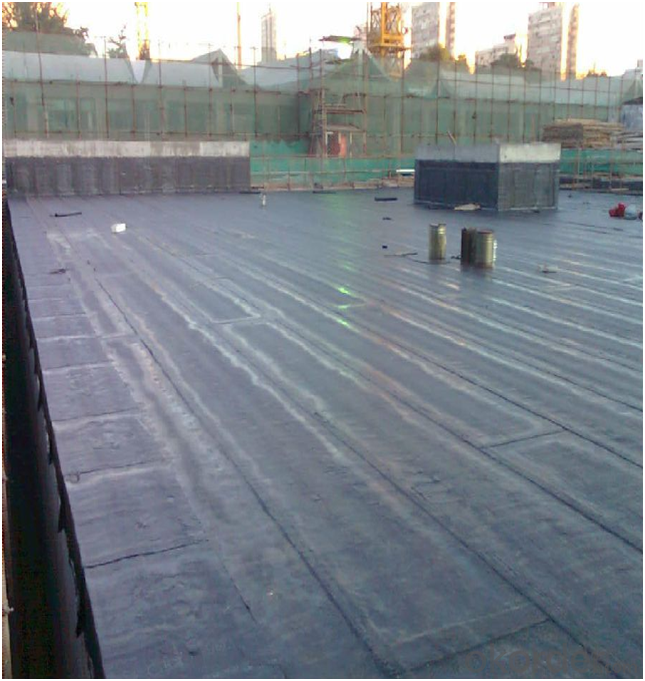


FAQ:
1. What are we supplying?
We are specialized in producing Colorful Asphalt Roof Shingle, SBS/APP modified bitumen waterproof membrane, Self adhesive bitumen waterproof membrane, PVC waterproofing membrane, EPDM rubber roofing membrane, Single Component Polyurethane Waterproof Coating, and Spray Polyurea Waterproof Coating.
2. How Many years experience do we have?
We have been exported to more than 20 countries in the past 15 years.
3. How long do we usually reply your request?
We always reply our customer within 24 hours.
- Q:Can a waterproofing membrane be used on concrete slabs or foundations?
- Concrete slabs or foundations can benefit from the application of a waterproofing membrane. These membranes are widely used in construction to safeguard structures against moisture damage and water infiltration. When a waterproofing membrane is applied to a concrete slab or foundation, it forms a protective barrier that prevents water from permeating the concrete and causing problems such as cracking, water damage, or mold growth. This specially designed membrane is capable of enduring hydrostatic pressure, which is the force exerted by still water, and it effectively ensures a dry environment. It is essential to choose a suitable waterproofing membrane that is compatible with the concrete and the specific project conditions. Adequate installation and maintenance of the membrane are also vital for long-lasting waterproofing effectiveness.
- Q:Can a waterproofing membrane be used as a vapor barrier?
- Yes, a waterproofing membrane can be used as a vapor barrier. Waterproofing membranes are designed to prevent the passage of water through a surface, such as a roof or foundation. In the process of preventing water penetration, these membranes also act as a vapor barrier, stopping the movement of water vapor. This helps to reduce the risk of condensation and moisture-related issues within a structure. However, it is important to note that not all waterproofing membranes are created equal and may have different levels of vapor resistance. Therefore, it is essential to select a waterproofing membrane that is specifically designed to also act as a vapor barrier if that is a requirement for the intended application.
- Q:Can waterproofing membranes be applied on roofs?
- Roofs can have waterproofing membranes applied to them, a practice commonly employed in the construction industry to add an extra layer of protection against water infiltration. These membranes, typically composed of synthetic materials like PVC, TPO, or EPDM, possess high resistance to water and effectively prevent leaks and water damage on roofs. Applying waterproofing membranes on roofs is a proven method for enhancing the longevity and durability of the roofing system, particularly in areas prone to heavy rainfall or extreme weather conditions. Moreover, waterproofing membranes are flexible and can be easily installed on various roofing materials such as concrete, metal, or asphalt shingles. Consequently, if you desire a watertight roof and wish to safeguard your property from water-related problems, the utilization of waterproofing membranes offers a dependable and efficient solution.
- Q:Can a waterproofing membrane be used for a water tank?
- Yes, a waterproofing membrane can be used for a water tank. Waterproofing membranes are designed to create a barrier against water penetration, making them suitable for use in water tanks to prevent leakage and ensure the integrity of the tank.
- Q:Are waterproofing membranes resistant to extreme weather conditions?
- Yes, waterproofing membranes are designed to be highly resistant to extreme weather conditions. They are engineered to withstand heavy rain, snow, high winds, and temperature fluctuations without compromising their effectiveness. They provide a durable barrier against moisture, protecting structures from water damage, leaks, and potential structural issues caused by extreme weather.
- Q:Does a waterproofing membrane require any special precautions during installation?
- Yes, a waterproofing membrane does require some special precautions during installation. Here are a few key considerations: 1. Surface Preparation: Before installing the waterproofing membrane, it is crucial to ensure that the surface is clean, dry, and free from any debris or loose particles. This may require thorough cleaning or even repairing any existing cracks or damages on the surface. 2. Adhesive Compatibility: It is important to use the appropriate adhesive or sealant that is compatible with the specific type of waterproofing membrane being installed. Using an incompatible adhesive can lead to poor adhesion, compromising the effectiveness of the waterproofing system. 3. Proper Application Technique: The membrane should be installed according to the manufacturer's guidelines, which may include specific instructions on temperature, humidity, and application technique. It is crucial to follow these instructions carefully to ensure proper adhesion and performance. 4. Seam and Joint Sealing: Paying attention to the seams and joints is critical as these areas are more prone to water penetration. Special care should be taken to properly seal and reinforce these areas using the recommended sealants or tapes provided by the manufacturer. 5. Quality Control: Regular quality control checks should be carried out during installation to ensure that the membrane is being installed correctly and any potential issues or defects are identified and addressed promptly. Overall, following the manufacturer's instructions and paying attention to the specific details of the installation process will help ensure that the waterproofing membrane is installed correctly and provides effective protection against water intrusion.
- Q:Can a waterproofing membrane be used for shower or bathroom installations?
- Yes, a waterproofing membrane can definitely be used for shower or bathroom installations. In fact, it is highly recommended to use a waterproofing membrane in these areas to prevent water damage and leakage. A waterproofing membrane is a thin layer of material that is applied to the walls, floors, and even ceilings of showers and bathrooms to create a barrier against moisture. This membrane acts as a waterproof barrier, preventing water from seeping through the tiled surfaces and into the underlying structures, such as the walls or subfloor. By using a waterproofing membrane, you can ensure that your shower or bathroom remains watertight and protected from water damage, mold growth, and potential structural issues. It is important to follow the manufacturer's instructions and guidelines when installing a waterproofing membrane to ensure its effectiveness and longevity.
- Q:Can a waterproofing membrane be used in conjunction with warranty or insurance policies?
- Typically, a waterproofing membrane can be used alongside warranty or insurance policies. Various waterproofing products and systems come with warranties that offer coverage for a specific duration, typically ranging from 5 to 20 years or even longer. These warranties often guarantee the effectiveness and durability of the waterproofing membrane, and may include provisions for repairs or replacements in the event of any failures or defects. Moreover, insurance policies may also provide coverage for damages caused by water leaks or flooding. By installing a waterproofing membrane, property owners can minimize the risk of water damage and potentially lower their insurance premiums. It is advisable to inquire with your insurance provider to determine if they offer any discounts or incentives for utilizing waterproofing systems. Nevertheless, it is crucial to note that the coverage provided by warranties and insurance policies may vary based on specific terms and conditions. It is recommended that you carefully review the details of the warranty or insurance policy and seek guidance from professionals to ensure that the waterproofing membrane aligns with the requirements and specifications outlined in these agreements.
- Q:Can waterproofing membranes be used on loading docks?
- Yes, waterproofing membranes can be used on loading docks. Waterproofing membranes are commonly used in various construction projects to prevent water infiltration and protect the underlying structure. Since loading docks are exposed to rain, snow, and other weather conditions, applying a waterproofing membrane can help to keep the dock area dry and prevent water damage.
- Q:Can a waterproofing membrane be used for storage tanks or containment areas?
- Yes, a waterproofing membrane can be used for storage tanks or containment areas. Waterproofing membranes are designed to provide a barrier against water or other liquid penetration, making them suitable for applications where containment is required. These membranes are typically made from materials such as rubber, PVC, or bitumen, which are known for their water-resistant properties. They can be applied to the interior or exterior surfaces of storage tanks or containment areas to prevent leaks and protect the structures from moisture damage. Additionally, waterproofing membranes can also help to prevent the growth of mold or mildew, ensuring a safe and hygienic environment for stored materials or liquids.
1. Manufacturer Overview |
|
|---|---|
| Location | |
| Year Established | |
| Annual Output Value | |
| Main Markets | |
| Company Certifications | |
2. Manufacturer Certificates |
|
|---|---|
| a) Certification Name | |
| Range | |
| Reference | |
| Validity Period | |
3. Manufacturer Capability |
|
|---|---|
| a)Trade Capacity | |
| Nearest Port | |
| Export Percentage | |
| No.of Employees in Trade Department | |
| Language Spoken: | |
| b)Factory Information | |
| Factory Size: | |
| No. of Production Lines | |
| Contract Manufacturing | |
| Product Price Range | |
Send your message to us
EPDM Waterproofing Roofing Membrane with 1.2mm 2.0mm
- Loading Port:
- Qingdao
- Payment Terms:
- TT OR LC
- Min Order Qty:
- 2000 m²
- Supply Capability:
- 800000 m²/month
OKorder Service Pledge
OKorder Financial Service
Similar products
New products
Hot products
Hot Searches
Related keywords

